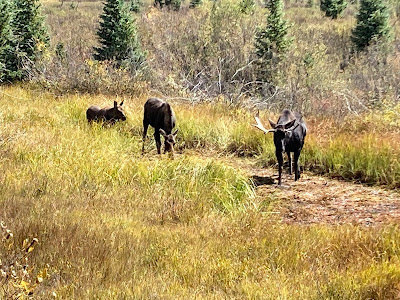by Yvette Henson, San Miguel Basin CSU Extension
Yesterday, I participated
in a class sponsored by Great Old Broads for Wilderness in the Northern San
Juan Region. (To learn more: https://www.greatoldbroads.org/about-us/ ) We explored a fen in the Ironton Park area on
Red Mountain pass in Ouray county. The class was led by Peggy Lyons, retired botanist for the
Colorado Natural Heritage Program in Western Colorado. She is an expert in native plants of the San
Juan mountains.
 |
| Peggy Lyons, botanist and fen class leader (photo shared with permission) |
A fen is a peat-accumulating wetland fed by ground water (as opposed to a bog which is fed by surface water). It takes thousands of years for fens to form. Fens are formed by and need year-round inflow of water, cold temperatures, and stable site conditions to remain. The perpetually saturated soils of fens create aerobic conditions which slow decomposition and allow organic matter to accumulate. To be classified as a fen, the organic soil layer must be at least 16” deep.
Fens are great carbon sinks. They also slow runoff, which helps reduce
flooding; the plants in fens filter pollutants, improving water quality; and
they provide habitat for plants and animals, unique to that habitat.
 |
| A moose family that was seen yesterday just across the highway. Moose habitat is wetland, including fens. |
The fen we explored was an iron fen. Iron fens are a special type of fen that occur on iron-rich soils and are unique to Colorado. The water that flows through the fens is very acidic (with a pH less than 4.5).
 |
| A view of Ironton Park Fen, looking North towards Ouray. |
The vegetation in fens is very different from surrounding ecosystems. In iron fens, with acidic soils, vegetation is primarily sedges, rushes, sphagnum mosses and specialized shrubs. The plants that were new to me were Bog birch and sphagnum moss.
 |
| bog birch, Betula glandulosa |
 |
| sphagnum moss, Sparganium angustifolium syn. Sphagnum angustifolium |
One of the class participants was retired from United States Geological Service and she told us about ferricrete, a stratified rock deposit in the San Juan region that indicates the existence of iron fens thousands of years ago.
 |
| ferricrete sedimentary deposit in the hillside above our fen, indicating their was a fen there thousands of years ago |
 |
| close up of a piece of ferricrete |
What a lovely and informative day I had in the mountains I love. It was good to see Peggy Lyons and meet new like-minded people.
 |
| Most of the participants in the Ironton Park fen class (photo shared with permission) |

No comments:
Post a Comment